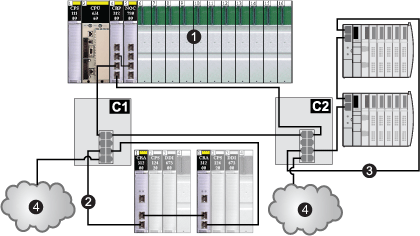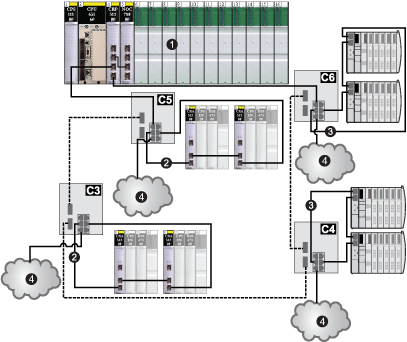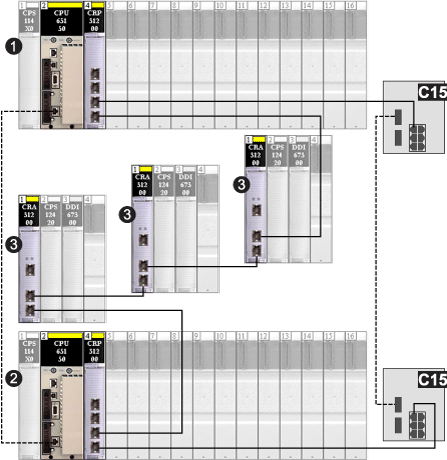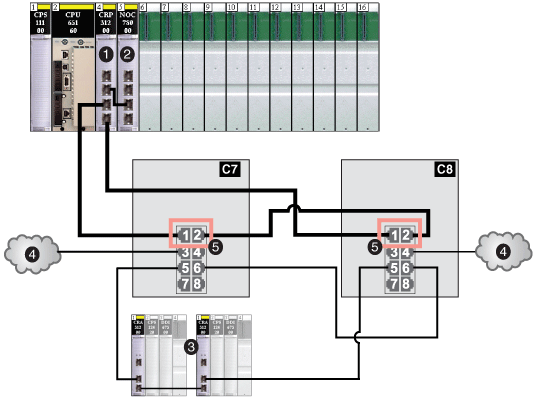|
|
Original instructions
|
|
Part
|
ConneXium Switch
|
Ports
|
|---|---|---|
|
TCSESM083F23F1
|
8TX 1280
|
|
|
TCSESM063F2CU1
|
6TX/2FX-MM
|
|
|
TCSESM063F2CS1
|
6TX/2FX-SM
|
|
|
NOTE: These 3 switches use firmware version 6.0 or greater. NOTE: You can achieve up to 2 km with multi-mode fiber cables and up to 15 km with single-mode fiber cables in a Quantum EIO system. |
||
 WARNING WARNING |
|
UNEXPECTED EQUIPMENT BEHAVIOR
Do not modify any parameter in the DRS predefined configuration you download to the switch, except enabling or disabling Ethernet ports.
You can enable/disable port mirroring and change the selection of the source ports that you want mirrored. Port mirroring is disabled by default. The destination port is set to port 8, and ports 1-7 are selected as source ports. Do not change the destination port. When using port mirroring, select the ports, for which you want to analyze the traffic, as the source ports.
Failure to follow these instructions can result in death, serious injury, or equipment damage.
|
 WARNING WARNING |
|
UNEXPECTED EQUIPMENT BEHAVIOR
Upgrading the firmware for a ConneXium extended managed switch removes all predefined configuration file settings. You need to re-download the predefined configuration file to the switch before placing the switch back in operation.
Failure to follow these instructions can result in death, serious injury, or equipment damage.
|



|
C1
|
a DRS using the C1 predefined configuration file for a copper remote I/O main ring with a remote I/O sub-ring and distributed I/O clouds
|
|
C2
|
a DRS using the C2 predefined configuration file for a copper remote I/O main ring with a distributed I/O sub-ring and distributed I/O clouds
|
|
1
|
a local rack with a CPU, a 140CRP31200 remote I/O head module, and a 140NOC78000 distributed I/O head module
|
|
2
|
a remote I/O sub-ring
|
|
3
|
a distributed I/O sub-ring
|
|
4
|
distributed I/O clouds
|
|
NOTICE
|
|
UNINTENDED EQUIPMENT OPERATION
When installing modules with fiber optic transceivers, do the following to help prevent dust and pollution from disrupting light production into the fiber optic cable.
Failure to follow these instructions can result in equipment damage.
|

|
C3
|
a DRS using the C3 predefined configuration file for a fiber remote I/O main ring and copper remote I/O sub-ring with distributed I/O clouds
|
|
C4
|
a DRS using the C4 predefined configuration file for a fiber remote I/O main ring and copper distributed I/O sub-ring with distributed I/O clouds
|
|
C5
|
a DRS using the C5 predefined configuration file for fiber/copper main ring connections and a remote I/O sub-ring with distributed I/O clouds
|
|
C6
|
a DRS using the C6 predefined configuration file for fiber/copper main ring connections and a distributed I/O sub-ring with distributed I/O clouds
|
|
1
|
a local rack with a CPU, a 140CRP31200 remote I/O head module, and a 140NOC78000 distributed I/O head module
|
|
2
|
remote I/O sub-rings
|
|
3
|
distributed I/O sub-rings
|
|
4
|
distributed I/O clouds
|

|
C15
|
2 DRSs using the C15 predefined configuration file for a fiber/copper connection for a long-haul link between Hot Standby systems
|
|
1
|
a local Hot Standby rack with a CPU and a 140CRP31200 remote I/O head module
|
|
2
|
a backup Hot Standby rack
|
|
3
|
3 remote I/O drops
|

|
C7
|
a master DRS using a C7 predefined configuration file for redundancy between the main ring and a remote I/O sub-ring (with non-redundant connections to distributed I/O clouds)
|
|
C8
|
a slave DRS using a C8 predefined configuration file for redundancy between the main ring and a remote I/O sub-ring (with non-redundant connections to distributed I/O clouds)
|
|
1
|
a 140CRP31200 remote I/O head module
|
|
2
|
a 140NOC78000 distributed I/O head module
|
|
3
|
a remote I/O sub-ring
|
|
4
|
2 distributed I/O clouds
|
|
5
|
4 inner ports
|